#Saint John
Text

Saint John's Episcopal Church, Edinburgh, SCOTLAND
1K notes
·
View notes
Photo

john the beloved / mary magdalene
#saint john#mary magdalen#like... there are parallels#they transgressed gender roles/social boundaries/class divides most and were therefore most drawn to christ#when others left him to die alone they stayed - understanding that suffering is bound up in love#and afterward they necessarily turned to solitude - belonging ultimately now to another place#i think they were dispositioned toward mysticism before they met him though#they loved him best!#whatever. im so normal about it#kritstrophies#catholic art
927 notes
·
View notes
Text

NE St Ann Street, Saint John, North Dakota.
69 notes
·
View notes
Photo

Sandro Botticelli, Madonna and Child with St. John the Baptist, detail, c. 1470–1475.
Musée du Louvre, Paris, France.
#1470#painting#sandro botticelli#madonna and child#detail#my edits#st. john the baptist#botticelli#musée du louvre#louvre#alessandro di mariano di vanni filipepi#Mythological painters#Mythological#italian#Renaissance painters#quattrocento painters#madonna#saint john#saint john the baptist
307 notes
·
View notes
Text

Saint John the Baptist in the Wilderness, Hieronymus Bosch (c. 1489) Museo Lázaro Galdiano, in Madrid.
#art#painting#art history#artists on tumblr#artwork#classic painting#classical art#classic art#hieronymus bosch#bosch#saint john the baptist#saint john#oilpainting#oil painting#oil on canvas#dutch artist#dutch painting#dutch golden age#lazaro galdiano#art museum#madrid#15th century#15th century art#religious painting#religious#religi#el bos#san jua#museo de arte
447 notes
·
View notes
Text
Favourite series: 008







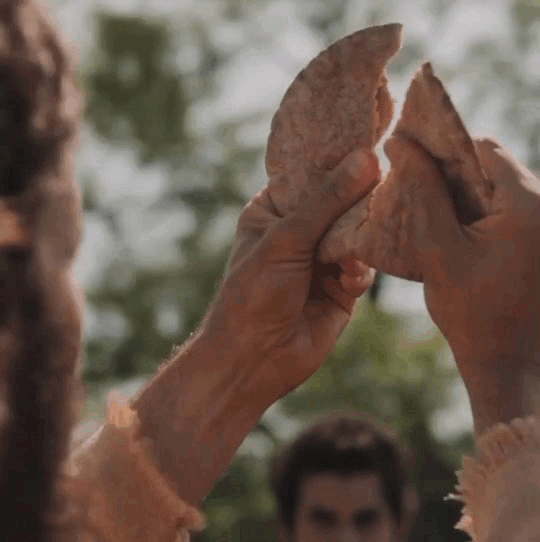

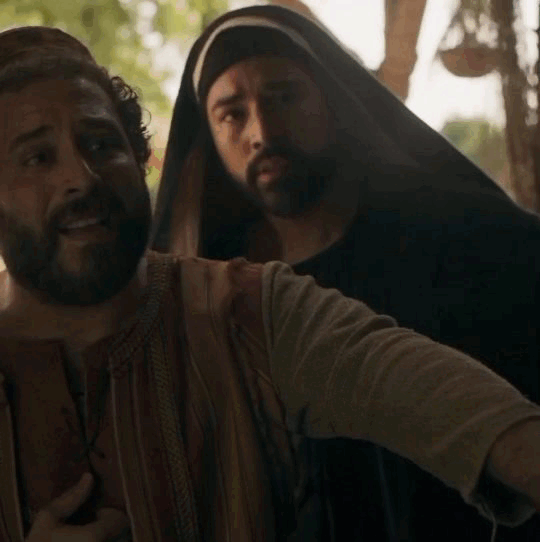
directed by Dallas Jenkins(2017-)
Prev || Next
#the chosen tv show#the chosen tv series#the chosen series#the chosen#jesus#jesus christ#my favorite#my favourite#favourite tv shows#simon peter#saint john#mary magdalene#john the evangelist#john the baptist#judas iscariot#disciples of christ
26 notes
·
View notes
Photo

Saint John - U.S. Virgin Islands (by anoldent)
#Saint John#U.S. Virgin Islands#Caribbean#Karibik#Nature#Landscape#Outdoor#View#Viewpoint#Ocean#Sea#Seascape#Photography#Travelling#Traveling#Travel#Tourism#Holiday#Urlaub#Reisen
333 notes
·
View notes
Photo
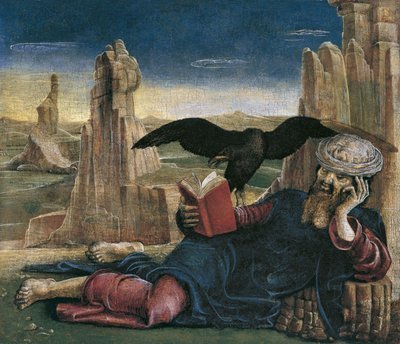
Johannes der Evangelist auf Patmos von Cosimo Tura
#kunst#kunstwerk#art#artwork#cosimo tura#artist#künstler#religion#religiöse kunst#religious art#johannes#john#johannes der evangelist#saint john#saint john the evangelist#patmos#bibel#bible#glaube#faith#beten#pray#jesus#christ#gott#god#vater#father#herr#lord
22 notes
·
View notes
Photo
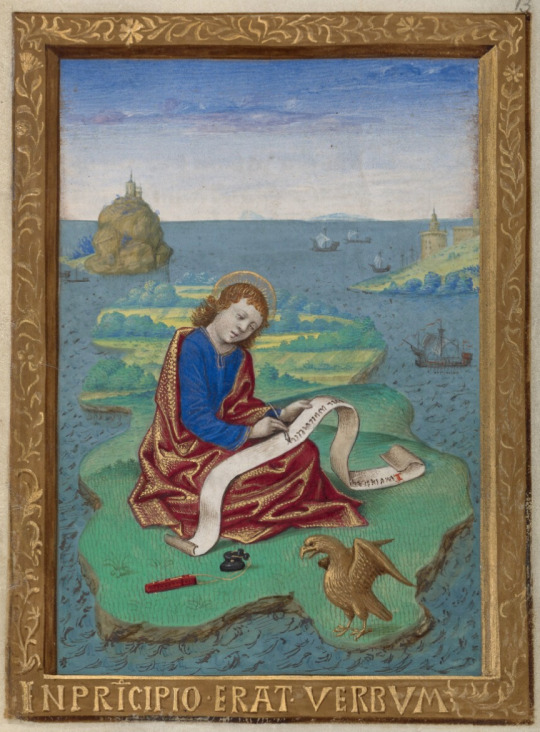
Saint John on Patmos
about 1480–1490
Georges Trubert (French, active Provence, France 1469 - 1508)
The J. Paul Getty Museum
107 notes
·
View notes
Text
Warning: This story describes details of an act of discrimination against members of the LGBTQ community.
Cheers and cries of "leave our kids alone" rang out as a person who looked to be in his teens used his teeth to rip apart a Pride flag. Several men gathered around, trying to light the pile of rainbow cloth on fire.
Unsuccessful, the unidentified person resorted to stomping on the flag before running back into a crowd of protesters
The protest Wednesday was one of dozens that happened across Canada as part of a march called "1 Million March 4 Children." The goal, according to some attendees in Saint John, was to protest against LGBTQ-inclusive education policies and curriculum in schools.
In Saint John, some teens stole Pride flags from counter-protesters and spit on them, stomped them and tried to burn them. Some adults cheered them on. [...]
Continue Reading.
Tagging: @politicsofcanada
49 notes
·
View notes
Text
The Dionysos gallery (4)
We finally reach the end of this long Dionysos series - and after dissecting the myth of Dionysos, we reach the conclusion of this gallery, kindly offered by the French Museum of Wine (you can find it all here).
First, I will include there the various paintings I did not have enough space to add in previous post, two paintings coupled with an analysis section I will loosely translate.
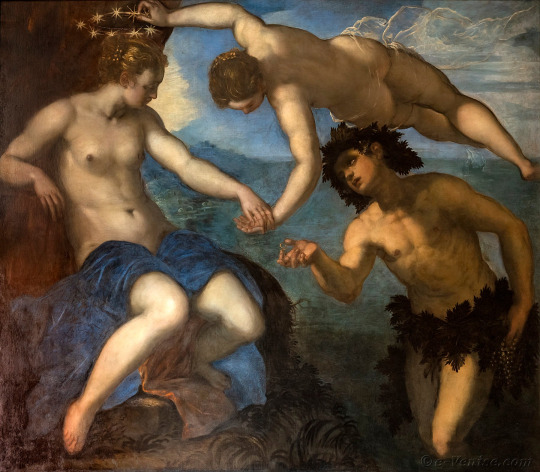
Le Tintoret's Ariadne, Venus and Bacchus
The motif of the encounter between Bacchus and Ariadne (who had been abandonned by Theseus on the island of Naxos) and Bacchus' offer to the woman of her famous gold crown made by Vulcan (according to Ovid's Fasts), has been a strong recurring motif in paintings, explored by numerous artists.
"Liber" or "Liber Pater" was originally a fertility/fecundity god whose worship took place within the oldest era of Ancient Rome. By the 7th century BCE onward Liber was associated with wine, and as a result the Romans ended up assimilating him with Bacchus/Dionysos. "Liber" as such became a mere Latin translation of the terms "Dionysos" or "Bacchus" - "Pater" meanwhile kept its role of expressing respect and adoration towards a god.

Jan van Bijlert's The Feast of the Gods
This 1630 painting currently kept at the Magnin Museum (Dijon) asks a quite troubling question: is this pagan scene... secretly a Christian Last Supper?
We are on Olympus. The gods are gathered for a feast. On the left we see Minerva, Diana, Mars and Venus, with Cupid by their side and Flora behind them. At the center of the table, a crowned Apollo appears holding his lyre. To the right we can recognize Hercules thanks to his mace, and Neptune with his trident. Unfortunately several of the Olympians are missing due to the painting having been cut off: for example there is a peacock, but no side of Juno. The motif of the "feast of the gods" was very popular in Holland, ever since an engraving by Goltzius "The Wedding of Psyche and Love" (see below).
However, van Bijlert's painting can be read very differently. In the Netherlands, due to the appearance and domination of Protestantism, all pictures had been banished from the temples, putting an end to the religious painting. As such, it seems that this painting hides within it a Christian scene of the Last Supper. Apollo at the center has the same halo as the Christ usualy has, and the characters surrounding him are twelve in total like the Apostles. Now, while it is a very interesting theory, we should stay careful. As we said before, it seems the reason some of the gods are missing is because the painting was cut (a practice very common at the time) - again, there's this peacock that implies Juno used to be included. Second element: yes the Christ has a golden halo in painting to symbolize his role as the Lord of the Heavens, but long before that, the idea of a halo of light did belong to Apollo. The Greeks saw him as the "solar god" by excellence, since he was the power that ruled and organized all things, and the one that regulated spirits and intelligences (in fact, he was complementary of Dionysos since Apollo tamed, controlled and shaped the vital force and bursts of life embodied by Dionysos).
Bijlert lived in Rome in the beginning of the 1620s and we know that, just like many of his fellow painters, he was deeply impressed by the art of Caravaggio. However, the Italian painter's fame was dwindling by then - and by the 1630s his art had lost any influence over European paintings. In this decade, Bijlert focused his works on the new international trend, the classicism. Here the composition of the panting and the diurnal luminosity are purely classicist. However, the dancing satyr and the leaning Bacchus on the foreground belong to the "naturalism" of Caravaggio: ocre-colored flesh, close-ups on bodies in non-conventional positions...
(Here is Goltzius' engraving)

Second part of this post, extending from the analysis above: Christianized Dionysos! Because yes, you might be surprised to learn that the motif of Dionysos/Bacchus in classical painting was heavily Christianized or syncretized with Christian figures...

Leonardo da Vinci's Saint John the Baptist
This Saint John the Baptiste has what has been called a "pagan beauty", and this painting with a Tuscany imagery "renews the syncretism of the patron of Florence" - perhaps due to the passion for Antiquity the town had when the painting was created. Indeed, while saint John here holds a cross symbolizing the Passion of the Christ, he is dressed in a panther's skin, reminding of the cloak of Bacchus...

Leonardo da Vinci's atelier: Saint John the Baptist-Bacchus
Once again this painting shows the syncretism between the figure of saint John and the character of Dionysos. The painting was first recorded, in the royal archives, as "Saint John in the desert". However, at the end of the 17th century, perhaps due to a restoration of the painting, the name was changed to "Bacchus in a landscape". Here we have Christian symbols: a finger raised to the sky, a stag resting on the ground... But we also have Bacchic attribute: a thyrsus, grapes, a panther's skin, and a crown of what might be ivy or vine-leaves.

Caravaggio's Saint John the Baptist
Here again we have the attributes of Bacchus: the vine, of which Bacchus was the god, and a ram, an animal traditionally sacrificed for the deity. Historians of painting are agreeing that the reason the Caravaggio associated John the Baptiste with Bacchus was because it allowed him to depict the saint naked, and eroticized, very probably to reflect his own homosexuality.
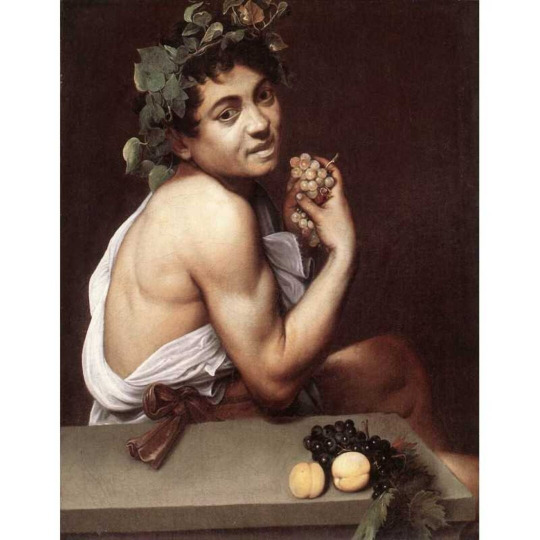
Caravaggio's "Sick young Bacchus/ The ill little Bachus"
This panting of Caravaggio has been interpreted as a self-portrait in a Bacchus-Christ fusion that is very sexual. Here, Caravaggio offers himself to the libertine cardinals of Rome, in an erotic "communion" (remember, "eucharis", means "the good flesh"). The action of carrying to his lips golden grapes gorged with juice is very sensual. Crowned with ivy, dressed in an ancient toga (which reveals a muscular shoulder), he is holding green grapes to his chest, as if he was about to press them. It has been thought that there the Greek wine of Dionysos is a mask or assimilation for the wine of the Christian mass - the invitation is for always a greater feast and bigger celebration, the wine of the Christ "subliming" the wine of Bacchus, ultimately becoming the wine an "universal mass" beyond any religion or era.
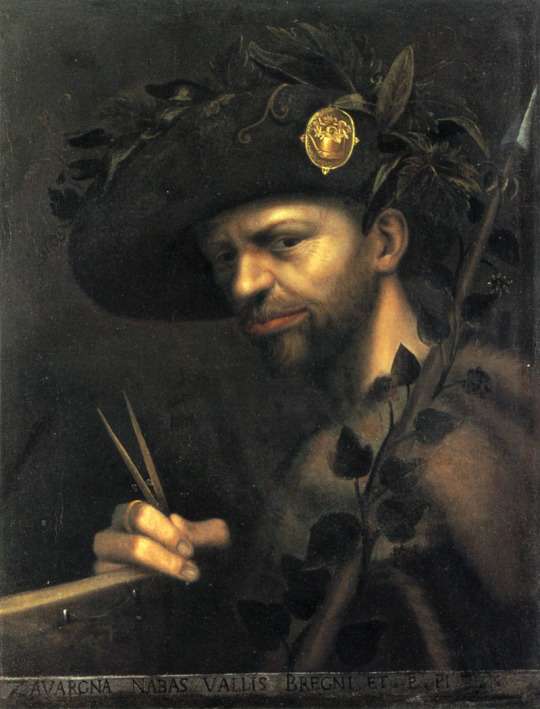
Giovanni Paolo Lomazzo's "Self portrait as a crowned Bacchus"
This painting depicts Giovanni Paolo Lomazzo in his outfit of president (called an "abbot") of the Acacademia della Val di Blenio (Ticino) - Lomazzo had just been named to this function, as the inscription at the bottom of the picture reminds the viewer. The Academy gathered all the best artists of Milan - painters, sculptors, musicians... And it was placed under the protection and patronage of Bacchus, the god that relieves from sorrows and worries, the god that inspires joy, the god that stimulates the mind and the creation, the god that frees from bondage. As such, it explains why this self-portrait has Lomazzo as Bacchus. It was an answer to the many disasters of the era, as well as to the new austerity imposed by the figures of the Counter-Reform - such as Charles Borromée, who was the archbishop of Milan and a cardinal within the Catholic church.
The Bacchic references are numerous here. The hat is wrapped in a garland of laurel and vine, with a medallion depicting vine too. There is a thyrsus surrounded in ivy. And finally there is a goat-skin, reminding of how when he was a child Bacchus was turned into a "kid" (baby goat) to avoid Juno's wrath. The compass however within the man's hand is not a symbol of Bacchus. Held like a paint-brush, it is meant to symbolize how Lomazzo "leads" and "drives" his own career like a captain would pilot his ship.
#the dionysos gallery#the art of the myth#dionysos#dionysus#bacchus#syncretism#saint john#john the baptist#art#painting#folk christianity#christian art
14 notes
·
View notes
Text

La Cathédrale et la Fountaine Saint-Jean-Baptiste, Lyon, Auvergne-Rhône-Alpes, FRANCE
#cathedrale#cathedral#catedral#fountaine#fountain#fuente#saint jean#saint john#san juan#baptiste#bautista#lyon#auvergne rhône alpes#france#francia#europe#europa
107 notes
·
View notes
Text






Saint John (2023) #1
18 notes
·
View notes
Text
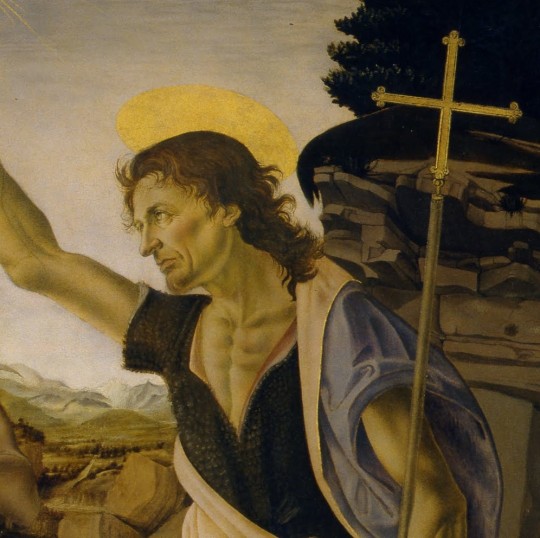
Andrea del Verrocchio - The Baptism of Christ. Detail. 1475
13 notes
·
View notes
Text

"Beneath the Sea", Countdown #22, 17 July 1971.
#science#biomedicine#underwater laboratory#magazine#Countdown#NASA#Tektite II#Scott Carpenter#John VanDerwalker#Great Lameshur Bay#Saint John#U.S. Virgin Islands#UK#1971
24 notes
·
View notes
Text
Today is the day of premiere of The Chosen season 4. I am so excited! I'm going to the cinema to see first two episodes. I discovered The Chosen (TV series) through Tumblr. I want to thank the person who posted the scene of the paralyzed man being lowered from the roof to Jesus.
This series is amazing! I was watching previous seasons with all my family. I recommend The Chosen whether you are religious or not. This series is about our lives and problems, how religion affects non-believers and what believers think(when they have a problem, for example). [My mother cried with Eden when she lost her child. My mother also lost my sibling. She felt like Eden.]
Beside that Jesus, our Lord became human. And that's beautiful. This series shows that Jesus is God and also Man.

When Big James and John told Jesus to use fire from Heaven He first was shocked by that request and then He told them the point of His mission here. That were a God's words.



After this explanation Jesus "switch on" His human side.
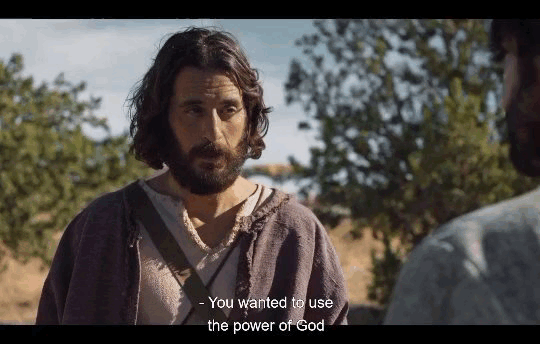
(I think that) He was like fire? No locust? Darkness? Only fire from Heaven? And then He just chuckles. He was is truly a Man.
He even played with Lazarus friends (IDK who they were).

Once more I recommend The Chosen.
#the chosen#the chosen series#the chosen season 4#jesus#jesus christ#jonatham roumie#big james#john#saint john#angel studios#god#holy trinity#the son of man
17 notes
·
View notes